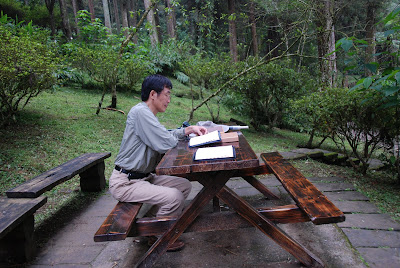Wufeng Shi Lu shi shenme? Wufeng ye you shi de lu ma?
Jintian zaoshang, wo chao Zhanggong Miao (樟公廟) de shanlu zou shangqu de shihou, moran faxian lubian de dangtuqiang-shang, xiezhe sige dada de zi: Wu Feng Shi Lu (霧峰詩路). Zai wangshang zoule yiduan lu, guoran kandao yishou Taiyu shi, biaoti shi: Ai Ceng de Yun (愛蹭的雲 The Playing Clouds). Ai Ceng jiushi "ai wan" (being fond of playing) de yisi.
Rong wo ba zhengshou shi chaolu ru xia:
愛蹭的雲四界飛
歡喜的風四界吹
人生若戲做你蹭
人生若戲做你飛
愛蹭的雲你厝佇叨位
愛蹭的雲你敢有地址
你欲按怎乎人相信
你欲按怎追求愛情
愛蹭的雲酷酷飛
愛蹭的 § 丟丟去
--詩:黃圻文 / 書:傅 清
Zhenshi tai youqu la! Zhe shi de zuozhe Huang Qiwen, hai shi wo erzi duo nian qian xiang ta "baishi-xueyi" de meishu laoshi ne! (Na shihou, erzi hai hen xiao. Women chule song ta qu Guoyu Ribao xue shuohua han zuowen, ouer ye rang ta xuexue meishu, tantan gangqin.) Xiangxin erzi hai jide zhewei duocai-duoyi de Huang laoshi ba!
Wo zai wangshang zou, bujiu, you kanjian lubian you zheyang yishou shi, biaoti wei: Hua (花 Flowers). Quan shi chaolu ru xia:
一月花喜洋洋
二月花香貢貢
三月花尚春風
四月花紅吱吱
五月花大富貴
六月花介迷人
七月花妖嬌欉
八月花黃葩葩
九月花青春夢
十月花尚好鼻
十一月花真秀氣
十二月花娶新娘
-- 詩文書清
Kan qilai zhexie shiju xie zai lubian de dangtuqiang-shang yi you yiduan man chang de suiyue le. Ziji youdian mohu-buqing. Youqi, "Hua" de zuozhe, daodi shi shei, wo shizai bugan queding, yinwei kan ye kan bu qingchu. (Ruo you chaocuo, hai qing duo baohan!)
Wo jixu wangshang zou. Qidai you gengduo de faxian. Danshi, shan-shang de wenzi you duo you meng [山上的蚊子又多又猛], wo liangzhi jiao bei yao de qiyang wubi -- zhen houhui jintian chuanle duanku lai zheli pashan! Wo zhi zoudao Zhanggong Miao (樟公廟) shangtou de yiduan lu, jiu zhehui tou, congcong xiale shan lai le.
Huijia de lu-shang, paile jizhang zhaopian (ru xia), yong de shi Sheng Yage Youzhiyuan xinren yuanjiandu (jian Yuwen Zhongxin de CEO) Ms. Luane Chiu suo zengsong de jinianpin -- Panasonic DMC-ZS7 shuwei xiangji -- you GPS dingwei gongneng de yo!**
** On my way home, I took some more pictures (see below) with the new camera -- Panasonic DMC-ZS7 digital camera -- which was given as a gift for me by Ms. Luane Chiu, the new supervisor of St. James' Kindergarten and also CEO of St. James' Language Institute.
- - -








.JPG)





.JPG)




.JPG)
.JPG)
.JPG)
.JPG)
.JPG)














DSC_0332.JPG)
DSC_0334.JPG)
DSC_0346.JPG)
DSC_0347.JPG)
































